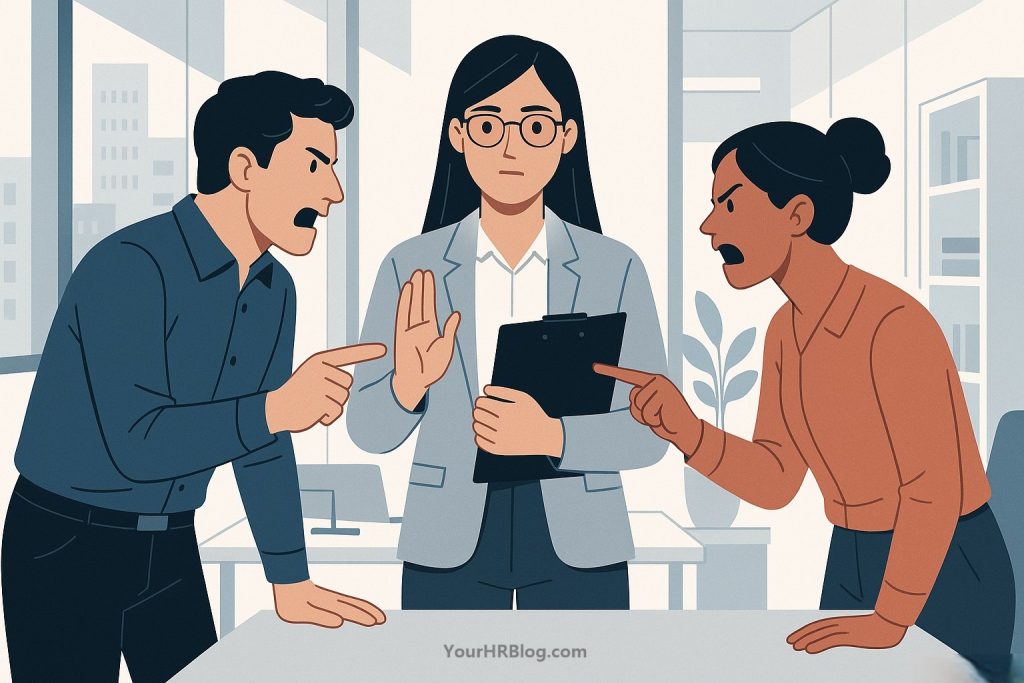Conflict at work is normal.
But when you’re the one responsible for handling workplace conflict in HR, the pressure hits different.
In my first few months, I faced a situation that escalated quickly

In my first few months in HR, I faced a conflict that escalated publicly. It started with frustration over project credit and quickly became a personal argument between two senior employees. Tensions rose. Voices did too. And before I knew it, I was trying to manage not just a dispute but a situation that could’ve impacted the whole team’s morale.
In this post, I’ll walk you through what happened, what I did wrong, how I fixed it, and the key lessons I now use to handle every workplace conflict with structure and confidence.
✅ Where It All Started: A Clash in a Team Meeting
It began during a weekly sprint meeting.
Two senior marketing team members — let’s call them Sarah and Raj — were reviewing a campaign timeline. Everything seemed normal… until Raj interrupted Sarah mid-presentation.
“That concept wasn’t yours. You skipped my feedback entirely.”
Sarah didn’t hold back.
“You didn’t respond to a single message. I carried the whole project.”
The room fell silent.
Other team members stared at their screens. Some muted their mics. One quietly messaged me on Slack:
“You might need to step in… This is getting bad.”
I was caught off guard. I was attending remotely. And worse — I froze. I didn’t say anything.
That moment taught me a powerful lesson: when HR stays silent, conflict grows louder.
✅ What I Did Wrong (And What Made Things Worse)
After the meeting, I sent both employees friendly messages:
“Hey, let’s clarify what happened. I’m sure it’s just a miscommunication.”
That was mistake #1. I tried to make it informal and non-confrontational. I thought a casual conversation would calm things down.
Here’s what actually happened:
- Sarah felt dismissed.
- Raj thought I was defending her.
- Neither felt heard.
Then came mistake #2: I didn’t document anything. No notes, no timestamps, no formal action. The department manager got involved by day two — asking, “What’s the status of this conflict?”
I had no formal record. Just screenshots and some feelings.
✅ What I Should Have Done Instead
Looking back, I can clearly see what I should have done — and what I now do in every conflict.
✅ 1. Pause the Meeting Immediately
When the situation escalated, I should have stepped in. Saying,
“Let’s pause here. I’ll follow up with both of you individually.”
would have stopped the damage in front of the team.
✅ 2. Set Formal 1:1 Meetings
Casual texts don’t solve real tension. I needed structured conversations with each person:
- Privately
- Without judgment
- With note-taking and time to speak
✅ 3. Acknowledge Emotions
Instead of “Let’s clarify this,” I should’ve said:
“I can see this has caused a lot of frustration. I want to fully understand both perspectives.”
People want to be heard first, not fixed.
✅ 4. Loop in Management Early
I thought I could fix it alone. But sometimes, HR must facilitate with authority — and that means including the right leaders without bias.
✅ How I Resolved It (Step by Step)
Once I realized my mistake, I switched gears and reopened the case — this time the right way.
🟩 Step 1: Separate Interviews
I scheduled 30-minute, one-on-one sessions with Raj and Sarah.
In each meeting, I asked:
- “What happened from your view?”
- “How did it make you feel?”
- “What would a fair outcome look like to you?”
I took detailed notes. I didn’t interrupt. And I didn’t offer solutions right away.
🟩 Step 2: Mediation with Ground Rules
Once both had shared their side, I invited them to a joint mediation session.
Before we started, I laid out 3 ground rules:
- Speak respectfully, no interruptions
- Focus on the issue, not the person
- The goal is understanding, not blame
During the session, something shifted. They both realized their communication had broken down — and that assumptions played a major role.
🟩 Step 3: Document the Outcome
We agreed on:
- Clear project roles
- Expectations for collaboration
- How to escalate future concerns
I shared the final summary with both employees and their manager, and we closed the case.
✅ The Outcome
The conflict didn’t destroy the team. In fact, trust improved.
Raj and Sarah still had differences — but now, they had a system for handling them.
More importantly, the rest of the team felt reassured. They saw that HR wasn’t afraid to act — and that fairness, not silence, is the rule.
✅ What I Learned from the Experience
This was a turning point in my HR career.
Before this, I thought HR’s role in conflict was about keeping peace.
Now I know it’s about
- Creating structure
- Listening deeply
- Facilitating safe conversations
- Being neutral — but never passive
I also learned that early intervention is key. Waiting only builds tension. Acting without structure invites bias.
✅ Tips for New HR Professionals
If you’re just starting your HR journey, here’s what I would tell you:
- Don’t delay conflict resolution. Pause the situation and schedule formal talks.
- Document everything. It protects you and builds clarity.
- Avoid informal chats for formal problems. Use real processes.
- Always acknowledge emotions. Even when people are wrong, they need to feel seen.
- Stay neutral. But be proactive.
Conclusion
Workplace conflict will happen — whether you’re in HR for one year or ten.
The difference is how you respond.
Don’t try to fix people. Instead, create a space where they can hear each other and move forward.
My early mistake nearly cost me trust. But with reflection, process, and empathy, I turned it into a learning experience — for me and for the entire team.
If you’re facing conflict now, remember: structure wins. And silence? It only makes the noise louder.
